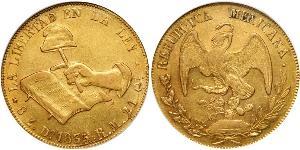| preceded by | ||||
|
||||
|
|||||||
|
|
|||||||
| succeeded by | ||||
|
| First Mexican Republic (1824–1835)from the Wikipedia | Read original article |
- For the current entity named United Mexican States, see Mexico.
| United Mexican States | ||||||
| Estados Unidos Mexicanos | ||||||
|
||||||
|
||||||
| Motto Religión, Independencia, Unión Religion, Independence, Union |
||||||
|
The United Mexican States in 1824.
|
||||||
| Capital | Mexico City | |||||
| Languages | Spanish (official), Nahuatl, Yucatec Maya, Mixtecan languages, Zapotec languages | |||||
| Religion | Roman Catholic | |||||
| Government | Federal Republic | |||||
| President | ||||||
| - | 1824–1829 | Guadalupe Victoria (first) | ||||
| - | 1835 | Miguel Barragán (last) | ||||
| Vice President | ||||||
| - | 1824–1827 | Nicolás Bravo | ||||
| - | 1829–1832 | Anastasio Bustamante | ||||
| - | 1833–1835 | Valentín Gómez Farías | ||||
| Legislature | Congress | |||||
| - | Upper house | Senate | ||||
| - | Lower house | Chamber of Deputies | ||||
| History | ||||||
| - | Constitution adopted | 4 October 1824 | ||||
| - | Centralist Republic established | 23 October 1835 | ||||
| Area | ||||||
| - | 1824 | 4,500,000 km² (1,737,460 sq mi) | ||||
| Population | ||||||
| - | 1824 est.[1] | 6,500,000 | ||||
| Density | 1.4 /km² (3.7 /sq mi) | |||||
| - | 1834 est.[1] | 7,734,292 | ||||
| Density | 1.7 /km² (4.5 /sq mi) | |||||
| Currency | Mexican real | |||||
| Today part of | ||||||
The First Federal Republic of Mexico (Spanish: Primera República Federal de México) was established on 4 October 1824, after the overthrow of the Mexican Empire of Agustin de Iturbide. In the new constitution, the republic took the name of United Mexican States (Spanish: Estados Unidos Mexicanos), and was defined as a representative federal republic, with Catholicism as the official and exclusive religion.[2]
However, most of the population largely ignored it. When Guadalupe Victoria was followed in office by Vicente Guerrero, who won the electoral but lost the popular vote, the Conservative Party saw an opportunity to seize control and led a coup under Anastasio Bustamante, who served as president from 1830 to 1832, and again from 1837 to 1841.
This coup set the pattern for Mexican politics during the 19th Century. Many governments rose and fell during a period of instability caused by factors including:
1. the control of the economic system by the large landowners, 2. the struggle over the status of Mexico's northern territories, which issued in a devastating defeat at the end of the Mexican–American War, and 3. the gulf in wealth and power between the Spanish-descended elite and the mixed-race majority.
The main political parties during this era were:
the Conservatives (favoring the Catholic Church (confessional state), the landowners, and a monarchy) and the Liberals (favoring secularism (secular state), the landless majority, and a republic).
Contents
History[edit]
Formation[edit]
|
Part of
a series on the
|
|---|
| History of Mexico |
 |
|
Spanish rule
|
|
First Republic
|
| Timeline |
| Mexico portal |
In December 1822, Generals Antonio López de Santa Anna and Guadalupe Victoria wrote and signed the Plan of Casa Mata. This was an agreement between these two generals, amongst other Mexican generals, governors, and high-ranking governmental officials, to abolish the monarchy and replace it with a republic. Several insurrections arose in the Mexican provinces beginning in December, but they were all put down by the Imperial Army, except for Santa Anna's forces in Veracruz.
This was because Santa Anna had previously made a secret agreement with the General Echávarri, the commander of the Imperial forces. By this agreement, the Plan of Casa Mata was to be proclaimed throughout Mexico on February 1, 1823 and Echávarri was to switch sides. This plan did not recognize the First Mexican Empire and called for the convening of a new Constituent Congress. The insurrectionists sent their proposal to the provincial delegations and requested their adherence to the plan. In the course of just six weeks, the Plan of Casa Mata travelled to such remote places as Texas, and almost all the provinces supported the plan.
Independence and Empire[edit]
On September 27, 1821, after three centuries of Spanish rule, and an 11-year war of independence, Mexico obtained its sovereignty. The Treaty of Córdoba recognized the New Spain as an independent empire, which took the name of Mexican Empire.
A minority of the Constituent Congress in search of stability chose as monarch the general Agustín de Iturbide who had led the war effort against Spain. He was proclaimed emperor of Mexico on May 18, 1822. Soon after, problems arose between the emperor and the Constituent Congress. Several members were jailed simply for expressing their disagreement with Iturbide and finally Iturbide decided to eliminate the elected Congress, establishing an appointed National Board in its place.
The dismissal of the Congress, the dictatorial style of government adopted by the Emperor, and the absence of solutions to the serious problems that the country was going through increased the conspiracies to change the imperial system. Antonio López de Santa Anna proclaimed the Plan of Casa Mata, which was later joined by Vicente Guerrero and Nicolás Bravo. Iturbide was then forced to reinstate the Congress and in a vain attempt to save the order and keep the situation favorable to his supporters, he abdicated on March 19, 1823.
However, the restored Congress declared the appointment of Iturbide void ab initio, and thus refused recognition of the abdication. On 8 April, the Congress declared the Plan of Iguala and the Treaty of Córdoba void as well. With that the Empire was dissolved and the country declared its freedom to establish itself as it saw fit.
New Constituent Congress[edit]
| This section is empty. You can help by adding to it. (March 2013) |
Early tension in the republic and civil war[edit]
Antonio López de Santa Anna, a former federalist turned centralist and eventual dictator, suspended the 1824 Constitution and replaced it with the Siete Leyes in 1835, a radical amendment that institutionalized the centralized form of government.
Several states openly rebelled against these changes. Northern Coahuila y Tejas, San Luis Potosí, Querétaro, Durango, Guanajuato, Michoacán, Yucatán, Jalisco, Nuevo León, Tamaulipas, and Zacatecas all disapproved. Civil war quickly spread across the Mexican states and three new governments declared independence: the Republic of Texas, the Republic of the Rio Grande and the Republic of Yucatán.
Texan Wars of Independence[edit]
|
|
||||||
In May 1835 Santa Anna brutally crushed a revolt in Zacatecas and marched towards Coahuila y Tejas. In April 1836, he was defeated in Texas, where Texans retained their independence and formed a separate republic.
Mexican Federalist War[edit]
|
|
||||||
There were further battles in 1839: Acajete (May 3), Alcantra (October 3–4), and the siege of Tampico (May 26 – June 4); and two more battles in 1840 Santa Rita de Morelos—or Morales—(March 24–25), and Saltillo (October 25).[3]
Notes[edit]
- ^ a b Evolución de la Población de México durante los años de 1521 al 2000
- ^ Federal Constitution of the United Mexican States (1824)
- ^ Jaques 2007, pp. XLV, 5, 26, 890, 907, 993.
References[edit]
- Jaques, Tony, ed. (2007), Dictionary of Battles and Sieges: A Guide to 8,500 Battles from Antiquity through the Twenty-first Century (3 volumes ed.), Greenwood Publishing Group, ISBN 978–0–313–33536–5
|
||||||||||||||||||||||||||||||||||||||











